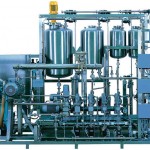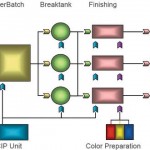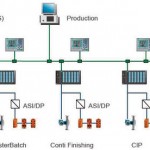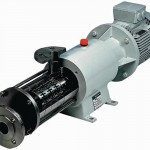Even in difficult economical times, liquid detergents, household cleaners and personal care products are often the mainstay of turnover. Personal care prod-ucts account for 12.6 billion euros in the personal care and detergent industry. This tends to be high-volume business with 200,000 t/a of fabric softener in Germany, for example. Batch production is mainly used for this type of product. With advantages like substantial cost reductions, stable quality and handling benefits, it can be interesting to look into the possibility of changing over to continuous production.
Dieter Hinz, Harm Zander
The manufacture of personal care products, household detergents and fabric softeners is very similar in many ways: nearly all the products concerned have a basic formulation (masterbatch). Various finishing components (e.g. pigment, active matter, perfume) must be added to obtain the final, saleable product. Up to fifteen different raw materials are needed to make a prod-uct that is distinguishable from rival articles.
Approximately 70 % of all existing production plants for liquid detergents, household cleaners and personal care items operate as batch systems. All the raw materials necessary for the formulation and the volume are transferred to a mixing tank. This has the advantage of high formulation flexibility (post-addition – even supplementary components not included in the original formulation can be added). Smaller tanks can be used to produce smaller batches. Batch traceability is sometimes demanded by quality standards.
The major drawbacks are the high space requirement (the main constraint if the production capacity is increased) and the heavy energy consumption (heating/cooling), as in most cases the complete batch has to be treated. At the end of one batch, further processing (intermediate storage/packing) is essential before a new batch can be started. This represents a serious restriction on flexibility. Last but not least, temperature, viscosity and pH control are time-consuming.
Continuous production, on the other hand, opens up better possibilities for just-in-time strategies and in-line, continuous quality control. Step-by-step automation options, up to and including fully automated formulation management, simplify the processes for the operator. Optimal SIP/CIP procedures mean less cleaning and less waste water. Since the system is completely closed during production, bacterial contamination is eliminated. High metering accuracy results in high quality as well as raw material savings – a strong argument in times of rising prices for natural resources.
Continuous production systems are characterised by a combination of high volume and small footprint. Additional intermediate storage is not normally required.
These advantages are very convincing: fabric softeners, floor cleaners, general household cleaners, washing-up liquids and liquid detergents as well as shampoos and shower or bath gels are increasingly produced in continuous mode.
Another important aspect of continuous production is the fact that manufacturers prefer to use highly concentrated tensides (anionic tensides, FAES = fatty alcohol ether sulphate) for logistical and hygienic reasons. These products have to be locally diluted with water – a challenging task.
During the addition of water, FAES forms intermediate products with an extremely high viscosity that are difficult to handle in standard mixing vessels. This leads to a significant increase in batch times coupled to a reduction in batch capacity.
Washing-up liquid – a typical example
In order to solve this problem, Bran+Luebbe developed the Conti MasterBatch & Finishing Technology. The core component of this continuous mixing system is the dynamic Pentax mixer, which handles the continuous in-line dilution step with total efficiency. A typical production system for washing-up liquid is described here as an example.
The masterbatch for a washing-up liquid generally starts with the dilution of FAES with 70 % active matter, which is taken directly from the storage tank (no intermediate tank is necessary) and diluted with deionised water. The dilution is performed by a dynamic in-line mixer equipped with a variable drive that adjusts to actual prod-uction capacity. A gel phase (70 –> 30 %) is formed as soon as contact is made with the water. The dynamic in-line Pentax mixer dilutes the base product down to the required concentration of less than 30 %. At the same time, other tensides and products needed for the basic formulation are added and mixed into the diluted material. This then forms the white product that is the masterbatch for the complete family of final products.
The next step in production is to split the base product into final products. In order to obtain a final product from the masterbatch, temperature sensitive perfume is added along with various other components (matting agent, pigment, preserv-atives). A dynamic in-line mixer is nor-mally used for this purpose; however, in specific cases a static mixer can be sufficient for the process step.
Within the finishing system, the components required for the formulation are continuously metered using precise positive-displacement pumps and homogeneously mixed into the product. Each additive line is controlled by in-line flow meters. Online analytics control the temperature, pH and viscosity. The result is a final product free of air that can be packed immediately.
This final product can be changed quickly if necessary without any problems, with only minimal loss of material and waste water from CIP cleaning. Like the masterbatch system, the finishing system has a very small footprint.
All the main components of the Conti MasterBatch & Finishing technology are produced within the SPX Group, the holding company of Bran+Luebbe. In addition to the Pentax in-line mixer, the metering pumps are likewise manufactured by B+L. Frequency controlled centrifugal pumps are preferred for adding the water. Higher-viscosity products are pumped by rotary displacement pumps from Waukesha, another SPX company. These models have a high and stable volumetric efficiency and are easy to clean. All flows are controlled by mass flow meters and a central control system (PCS) guarantees the correct formulation by adjusting the pumping speed of the individual pumps in case of deviations.
In-line mixer for very fine material dispersion
Motor-driven (fixed/variable-speed) Pentax in-line mixers are used to make stable emulsions of non-mixable components, produce finely dispersed suspensions in a viscous base material or perform dilutions that are otherwise difficult to achieve.
The comparatively large volume of the mixer and the use of a pre-mix chamber allow continuous operation and reaction even under challenging conditions.
Typical examples include:
- Dilution of ether sulphate paste with water during the production of shampoos
- Neutralisation of alkyl-benzene-sulphonic acid with caustic as the basis for washing-up liquids and household detergents
- Saponification of fatty acids with potassium hydroxide during the production of liquid detergents
All these processes need only one pass of the components through the mixer before the products can be used in the downstream process steps.
The Pentax mixer is a multi-stage, multi-frequency unit built around a horizontally rotating stator/rotor system. A comb-type rotor is used for low-viscosity operation or a pin-type version for higher viscosities. The product passing through the rotating stator/rotor system always has to search for new passages and is alternately exposed to high acceleration and delay action.
The strong shear introduced in this way leads to high dispersion effects for tiny droplet sizes in emulsions or very fine dispersion in suspensions. The Pentax is consequently ideal for mixing and neutralisation reactions.
The mixer inlet is equipped with a multi-blade impeller that operates in the pre-mix chamber. The mixer can even be fed with an oscillating positive-displacement pump, because the pre-mix chamber holds enough material to produce the correct formulation before the material enters the mixer’s high-shear zone.
The products often have non-Newtonian properties, so that the real viscosity within the mixer is not predictable. To enable the necessary rotation speed to be correctly designed, for instance, motor sizing tests can be performed at the Bran+Luebbe testing laboratory in Norderstedt (Germany).
Hall 9.0, Booth H30
Online-Info www.cpp-net.com/2209400

Tensides or other active matter handle all the hard work in a cleaning process with household detergents. They reduce the surface tension of the water and provide optimal wetting. At the same time, they disperse the dirt on the surface to be cleaned. In detergents, washing-up liquids, shampoos, shower gels, etc. they are essential to increase the dispersibility of fat or dirt particles adhering to the skin or fabric. They are also necessary to make cosmetic articles containing oil-in-water (O/W) or water-in-oil (W/O) emulsions.
In 2005, an EU regulation came into force banning all tensides in fabric softeners or any kind of detergent unless they are totally biodegradable.
There are four main tenside groups: more than 80% are anionic or non-ionic while a small amount are amphoteric. Cationic tensides are mainly used in fabric softeners to give the dry fabric a soft grip.
Share:










